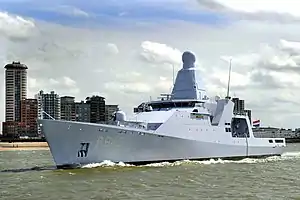HNLMS Groningen (P843)
HNLMS Groningen is a Holland-class offshore patrol vessel operated by the Royal Netherlands Navy.
 HNLMS Groningen | |
| History | |
|---|---|
| Name: | Groningen |
| Operator: |
|
| Builder: | Damen Group |
| Laid down: | 9 April 2010 |
| Launched: | 21 April 2011 |
| Commissioned: | 29 November 2013 |
| Identification: |
|
| Status: | Active |
| General characteristics | |
| Class and type: | Holland-class offshore patrol vessel |
| Displacement: | 3.750 gross tons |
| Length: | 108.4 m (355 ft 8 in) |
| Beam: | 16 m (52 ft 6 in) |
| Draught: | 4.55 m (14 ft 11 in) |
| Propulsion: |
|
| Speed: | 20 knots (37 km/h; 23 mph) |
| Range: | 5,000 nautical miles (9,300 km; 5,800 mi) at 15 knots (28 km/h; 17 mph) |
| Endurance: | 21 days[1] |
| Boats & landing craft carried: |
|
| Complement: | 54 (+ additional space for 40) |
| Sensors and processing systems: |
|
| Armament: |
|
| Aircraft carried: | 1 x NH90 helicopter[2] |
| Aviation facilities: | fully equipped hangar and flight deck for one medium-sized helicopter |
The vessel was built in the Romanian shipyards in Galati, by the Dutch firm Damen Group.[3]
Integrated mast module
The integrated mast module (IMM) has been built to an innovative concept. The mast houses all systems which form the "eyes and ears" of the ship. The ship can efficiently detect pirate and smuggling boats while keeping an eye on the skies as well. For the first time camera, radar and communications antenna systems are merged into one mast structure. This allows the ship to see flying and floating objects. The means of communication in the mast making it possible to carry out worldwide operations in conjunction with aircraft and ships.
Service history
2012
In late 2012 Groningen was exercising with HNLMS Friesland when MV Baltic Ace sank after a collision with another ship. Both Holland-class offshore patrol vessels assisted in the search for survivors.[4]
2014
On 28 April, Groningen departed Den Helder for deployment to the Caribbean on counter-drug operations and coast guard duties. On her way to the Caribbean she completed multiple exercises with six other European navies (MAOC-N).
In early June Groningen received an overnight notification from the US Coast Guard. A patrol plane saw a boat, a so-called go-fast, heading north at high speed. A US helicopter on board the ship took off immediately. Groningen itself headed to the specified location off the coast of Panama. When the smugglers heard the helicopter, they jettisoned their cargo. Groningen arrived moments later. The crew managed to retrieve multiple packages of drugs from the water. They recovered about half of the estimated 300 kilograms (660 lb).
The three smugglers were arrested and transferred to the Coast Guard.[5] She returned home to Vlissingen on 5 September for a short maintenance period.[6]
On 29 December two Russian navy vessels, the destroyer Vice-Admiral Kulakov and a tug from the Sliva-class sailed along the Dutch coast being escorted by Groningen.[7]
2015
On 9 August Groningen departed Den Helder for a four-month deployment off the coast of Somalia, as part of the EU anti-piracy mission Atalanta.[8] On 11 December she sailed back into her homeport.[9]
2016
In 2016 Groningen was deployed to the Caribbean on counter-drug operations and coast guard duties.
2018
In December 2018, the Royal Netherlands Navy (RNLN) was reported to be planning to trial a new crewing concept for its Holland-class offshore patrol vessels (OPVs) and selected Groningen for this two-year long pilot project. The main purpose of the project is to provide clarity for crews to know when they are deployed and when they are back home.[10]
References
- "The Holland-class OPVs Will Need A Change". Information Dissemination. 12 March 2010. Retrieved 4 January 2016.
- "Oceangoing Patrol Vessel" (in Dutch). Navy Inside. Archived from the original on 4 May 2007. Retrieved 5 August 2008.
- "The Netherlands: Damen Schelde Naval Starts SAT for Patrol Vessel Zeeland". World Maritime News. Retrieved 24 August 2016.
- "Navy deployed for rescue in North Sea". Ministry of Defence. Archived from the original on 19 August 2016. Retrieved 6 July 2016.
- "Patrol Vessel captures drugs in Panama". Ministry of Defence. Archived from the original on 19 August 2016. Retrieved 6 July 2016.
- "Groningen back from the West". Ministry of Defence. Archived from the original on 19 August 2016. Retrieved 6 July 2016.
- "Groningen escorts Russian navy in North Sea". Ministry of Defence. Archived from the original on 19 August 2016. Retrieved 6 July 2016.
- "Patrol Vessel for the first time on anti-piracy mission". Ministry of Defence. Archived from the original on 19 August 2016. Retrieved 6 July 2016.
- "Appreciation for returning piracy fighter HNLMS Groningen". Ministry of Defence. Archived from the original on 19 August 2016. Retrieved 6 July 2016.
- "PRNLN to trial new crewing concept for Holland-class OPVs". IHS Janes 360. 7 December 2018. Retrieved 9 December 2018.
- "2 militairen omgekomen bij helikoptercrash in Caribische Zee". rijksoverheid.nl. Retrieved 14 December 2020.
- "NH-90 helikopter Zr.Ms. Groningen neergestort". marineschepen.nl. Retrieved 14 December 2020.